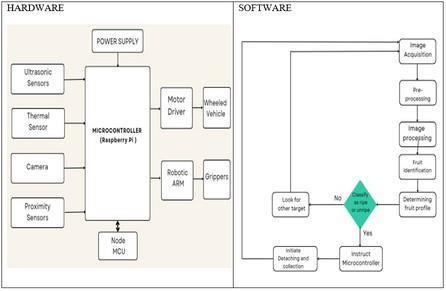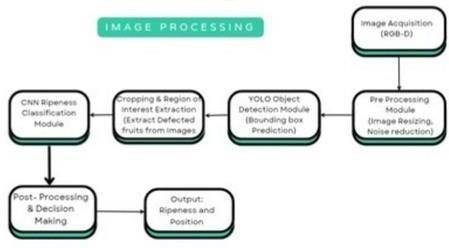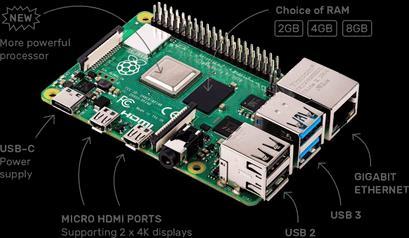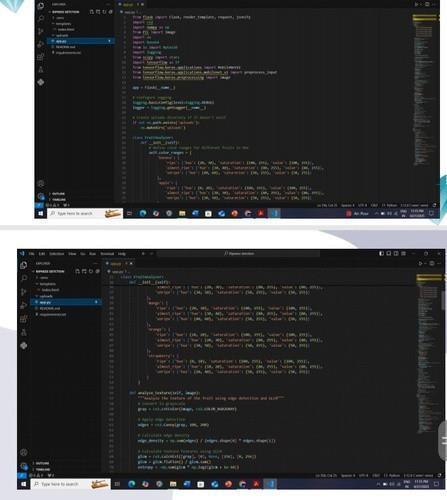
International Research Journal of Engineering and Technology (IRJET) e-ISSN: 2395-0056
Volume: 12 Issue: 05 | May 2025 www.irjet.net p-ISSN: 2395-0072


International Research Journal of Engineering and Technology (IRJET) e-ISSN: 2395-0056
Volume: 12 Issue: 05 | May 2025 www.irjet.net p-ISSN: 2395-0072
Khushi Joshi1, Swastika Tripathi2, Anshika Patel3, Er.Sonam Singh4
*1234Department of Electronics And Communication Engineering SRMCEM, Lucknow, Uttar Pradesh, India *** -
ABSTRACT
The agricultural sector is increasingly turning to automation to address labor shortages and enhance productivity. One promising development in this area is the smart fruit-picking robot which helps to improve efficiency, reduce labor dependency, and maintain consistent quality. This project introduces a smart fruit harvesting robot specifically designed to efficiently harvest lightweight fruits such as oranges, apples, and guavas using advanced image processing techniques, Convolutional Neural Networks (CNNs) implemented in Python and the You Only Look Once (YOLO) object detection algorithmtoidentifyandlocateripefruitsinrealtime.Thesystemintegratesahigh-resolutioncamerawithaRaspberryPito capturereal-timeimagesoftheplants.UsingPython,theimagesareprocessedtofilterbackgroundnoiseandisolatepotential fruit candidates based on color, shape, and texture. A pre-trained CNN model then classifies the fruits based on ripeness, ensuring only ripe fruits are selected for harvesting. Once a ripe fruit is identified and localized, the robot calculates its positionusingdepthestimationandcoordinatesaroboticarmwithasoftgrippertoharvestthefruitgentlyandprecisely. The system is equipped with basic obstacle avoidance and path-planning capabilities, allowing it to navigate through fields autonomously.
Preliminarytestinghasshownhighaccuracyinfruitdetectionandeffectiveharvestingwithminimaldamagetoboththefruits and plants. The proposed smart fruit harvesting robot demonstrates significant potential in reducing labor costs, increasing harvestingefficiency,andcontributingtotheadvancementofprecisionagriculturethroughAI-drivenautomation.
Keywords: Convolutional Neural Networks (CNN), Precision Agriculture, Robotic Arm with soft gripper, Autonomous Navigation.
The agricultural industry is undergoing a technological transformation, with automation playing a key role in addressing challenges such as labor shortages, increasing demand, and the need for precision farming. One critical task in horticulture that demands precision and efficiency is fruit harvesting, particularly for lightweight and delicate fruits such as oranges, apples,guavas.Manualharvestingofthesefruitsislabor-intensive,time-consuming,andpronetoinconsistencyanddamage. Toovercomethesechallenges,smartroboticsolutionsarebeingdevelopedtoautomatethefruit-pickingprocesswithhigher speed,accuracy,andreliability.Thisprojectfocuseson thedevelopment ofa smart fruitharvestingrobot thatutilizesimage processingtechniquesandartificialintelligencetodetectandharvestlightweightfruitsefficiently
A traditional fruit harvesting relies heavily on manual labor, which can be time-consuming, costly, and prone to inconsistenciesduetohumanerrorandfatigue.Incontrast,smartfruitharvestingrobotsuseadvancedtechnologiessuchas computervision,machinelearning,roboticarms,andsensorstoidentify ripefruits,determinethe bestpicking strategy, and harvestwithoutdamagingthefruitorplant.
Ahigh-resolutioncameracapturesimagesofthecrops,whichareprocessedusingOpenCVinPythontoenhanceimagequality andremovenoise.YOLOquicklydetectsmultiplefruitsinasingleframe,andaCNNmodelverifiestheirripeness.Aswerefer to other models we found the arm mechanism becoming complex and not easy to function the robot. So we use scissor lifts techniqueforheightenedtresstopickthefruitswithoutcausingharmand thiswillmakethemechanismlesscomplex,costeffectiveandeffiecnt.Onceidentified,aroboticarmwithasoftgrippermechanismisdeployedtogentlypickthefruitwithout causing damage. The system also includes path planning for obstacle avoidance capabilities. This smart harvesting robot representsasignficantsteptowardintelligent,automated,andscalableagriculturalpractices.

International Research Journal of Engineering and Technology (IRJET) e-ISSN: 2395-0056
Volume: 12 Issue: 05 | May 2025 www.irjet.net p-ISSN: 2395-0072
Cultivation of fruit crops plays a very important role within the prosperity of any nation. Productive growth and high yield productionoffruitsisnecessaryandrequiredfortheagriculturalindustry.Theliteraturereviewofpapersaregivenbelow:
Takashi Yoshida,(2022) [1]
Fruit harvesting is very labor-intensive. Single-arm robots are slow and inefficient for commercial farming. This paper proposesadual-armrobotthatcanpickfruitssimultaneouslyusingcoordinatedcontrolandmachinevision,improvingspeed and efficiency. However, the paper has notable shortcomings, including limited real- world testing, lack of cost analysis, and insufficientdiscussiononadaptabilityandcomparativeperformance.
Various studies have focused on developing harvesting robots. These studies can be classified into two categories. The first categorymainlyfocusesondetectionandlocalizationoffruitsusingsensors.
Xiaohua Zhang, Arash Toudeshki, Reza Ehsani Haoling Li (2022) [2]
Thispaperpresentsanovelapproachforyieldestimationofcitrusfruitsusingrapidimageprocessingtechniques. Traditional yieldestimationmethodsrelyonmanualsampling,whichislabor-intensiveandtime-consuming.Withadvancementsinimage processingandautonomousplatforms,suchasunmannedaerialvehicles,fasterandmoreaccuratetechniqueshaveemerged. ThestudyintroducesanalgorithmutilizingtheCIELabcolorspacetoseparatecitrusfruitsfromtheirnaturalbackground.It employsimagesegmentationtechniques,specificallytheCircleHoughTransform,tocountandestimatefruityield.
Florentinus Budi Setiawan, Adipradana and Leonardus Heru Pratomo (2023) [3]
Thispaperintroducesafruitripenessclassificationsystemthatleveragesdeeplearningtechniques,specificallyConvolutional NeuralNetworks(CNNs).Theresearchersdevelopeda model thatcanaccuratelyclassify fruitsintodifferentripenessstages based on image data. The system is trained on a dataset of fruit images captured under various conditions to improve its robustness.TheuseofCNNsenablesthemodel toautomaticallylearnand extractrelevantfeaturesfromtheimages,suchas color and texture, which are critical indicators of ripeness. This technology can be integrated into automated harvesting systemstoensureonlyappropriatelyripened fruitsarepicked,enhancingproductqualityandreducingwaste.
Ruilong Gao, Qiaojun Zhou, Songxiao Cao, and Qing Jiang (2023) [4]
Gao and colleagues focus on optimizing the picking path of apple-harvesting robots using an improved Particle Swarm Optimization (PSO) algorithm. Their research aims to reduce the time and energy consumption involved in navigating an orchardwhilemaximizingharvestingefficiency.TheimprovedPSOalgorithmincorporates adaptive mechanisms to enhance convergence speed and avoid local optima, ensuring more efficient andeffectivepathplanning.
Thepaperincludessimulationsandexperimentalresultsshowingthealgorithm’sabilitytoadapttodifferentorchardlayouts andfruitdistributions.Thisworksignificantlycontributestomakingfruit-pickingrobotsmore practical and efficient in realworldscenarios.
J. Zhang, Ningbo Kang, Qianjin Qu (2024) [5]
Thisreviewpaperprovidesabroadoverviewofthetechnologicaldevelopmentsinautomaticfruitpicking.Itcategorizesthe various technologies used, including mechanical systems, robotic arms, vision systems, and AI- based decision-making algorithms. The authors analyze existing systems in terms of performance, adaptability, and economic feasibility. They also highlight the ongoing challenges such as handling delicate fruits, dealing with occlusions, and adapting to diverse orchard environments.Thepaperemphasizestheintegrationofinterdisciplinarytechnologies robotics,AI,andsensornetworks as thekeytoadvancingtheautomation
Aifeng Ren et al. (2020) [6]
This study proposes a machine learning-driven, non- invasive method to assess the quality of fresh fruits. Published in the IEEE Sensors Journal, the research combines various sensor technologies with intelligent algorithms to evaluate freshness

International Research Journal of Engineering and Technology (IRJET) e-ISSN: 2395-0056
Volume: 12 Issue: 05 | May 2025 www.irjet.net p-ISSN: 2395-0072
without damaging the produce. The authors demonstrate that usingfeatures such as color, texture, and possibly smell or firmness can yield accurate classifications, which iscrucialforautomatedqualitycontrolinsupplychains.
Enrico Bellocchio et al. (2019) [7]
This study, from the IEEE Robotics and Automation Letters, introduces a weakly supervised deep learning method for countingfruitsinorchardimagestoestimateyield.Unliketraditionalapproachesthatrequiremanuallylabeleddatasets,this method leverages spatial consistency assumptions (i.e., the tendency of fruits to appear in clusters and structured arrangements)toenhancelearningfromlimitedlabels.Thisweaksupervisionsignificantly reducesthecostandeffortofdata annotation, while still achieving reliable performance. The model can be deployed on agricultural drones or ground-based robotstocountfruitsacrosslargefields,makingitapowerfultoolforpre-harvestplanningandresourceoptimization.
Gianluigi Ciocca et al. (2020) [8]
Published in IEEE Access, this paper focuses on identifying the “state” of food items (e.g., raw, cooked, fresh, spoiled) from imagesusingdeeplearning. TheauthorsutilizedConvolutional Neural Networks(CNNs)to extracthigh- level deepfeatures from food images. These features are then fed into classification models that categorize the food’s current condition.The study also evaluates the effectiveness of different CNNarchitecturesandhighlightsthemostdiscriminativeimagefeatures for food quality analysis. This research supports automated systems for food safety monitoring in kitchens, restaurants, and grocery stores byenablingmachinestorecognizeandclassifyfoodconditionswithminimalhumaninvolvement.
Guantao Xuan et al. (2020) [9]
Thisresearch,featured in IEEEAccess,addressesthe challenge of detectingapples in their natural growing conditionsusing deeplearningtechniques.Theauthorstrainedadetectionmodeltolocateapplesincomplexenvironments with varying light, occlusion from leaves or branches, and inconsistent fruit sizes. They usedadvancedCNN-basedobjectdetectionalgorithms suchasYOLOorFasterR-CNNforreal-timeperformance.Theresultsshowedhighaccuracyandrobustness,evenincluttered backgrounds.Thistechnologyisessentialforautomatingtheappleharvestingprocess,whererobotsneedtoaccuratelylocate andidentifyfruitswithoutdamagingthemormissingripeones.
Muladi Muladi et al. (2020) [10]
This study, presented at ICAMIMIA 2020, explores the use of a backpropagation neural network to classify the edibility of Manalagi apples a popular Indonesian apple variety. The researchers extracted features such as skin color, shape, and possibly internal characteristics using non-destructive techniques. These features were input into a neural network that classified apples as either suitable or unsuitable for consumption. This classification model assists in automating quality checks,reducingthechancesofspoiledfruitsreachingconsumersandenhancingpost-harvestprocessingsystems.
Wilson Castro et al. (2019) [11]
Thispaper, alsopublishedinIEEEAccess, focusesonclassifyingCapegooseberries byripenesslevel using machinelearning algorithms. The authors compared various color spaces (like RGB, HSV, LAB) to determine which provided the most discriminative features for classifying ripeness. Using supervised learning models, they trained classifiers on color-based features extracted from fruit images. The study demonstrates that certain color spaces especially when combined with textureorshapedata improveclassificationaccuracy.Thesystemcanbeintegratedintoautomatedsortinglinesormobile appsforfarmers,ensuringthatonlyoptimallyripefruitsareharvestedorsold.
Yunchao Tang, Mingyou Chen, Chenglin Wang, Lufeng Luo [2020] [12]
It’sareviewbyYunchaoTangetal.,publishedonMay19,2020,providesanin-depthreviewofthestate-of-the-arttechniques used in machine vision for automated fruit picking. The study highlights how vision-based technologies are revolutionizing agriculture by enhancing the efficiency, intelligence, and remote operability of fruit- picking robots in complex outdoor environments. However,despitetheseadvancements,thepaperpoints outseveraltechnicalchallengesthathinderthewidescalecommercialdeploymentofsuchsystems primarilyduetoissuesinprecisefruitrecognitionandlocalizationinvaried lightingandocclusionscenarios.

International Research Journal of Engineering and Technology (IRJET) e-ISSN: 2395-0056
Volume: 12 Issue: 05 | May 2025 www.irjet.net p-ISSN: 2395-0072
The review focuses on the progress and applications of vision systems in key tasks such as target recognition, 3D reconstruction, and fault tolerance in unstructured agricultural environments. It discusses both traditional digital image processingmethodsandmoderndeeplearning-basedapproachesusedinidentifyingandlocatingfruits.Thestudyconcludes byidentifyingmajorfuturechallenges,suchasimprovingrecognitionunderocclusion,handlingdifferentlightingconditions, and enhancing real- time processing capabilities. This comprehensive review serves as a valuable resource for researchers aimingtodevelopmorereliableandscalableroboticharvestingsystemsusingvisiontechnologies.
Yingqiong Peng, Muxin Liao et al. (2019) [13]
ThispaperpresentsadeeplearningapproachcalledFB-CNN(FeatureFusion-BasedConvolutionalNeuralNetwork) for the classification of fruit fly images. The challenge of identifying and classifying fruit flies,whichiscrucialforpestcontrolin agriculture, requires high accuracy due to the subtle visual differences among species.The researchers address this by proposingabilinearCNNarchitecturethatintegratesboth globalandlocalfeaturesthroughafeaturefusionmechanism.This allows the model to better capture fine- grained image details while maintaining robust general features, improving classification performance. The paper evaluates the model using a dataset of fruit fly images and shows that FB-CNN outperforms conventional CNN models, demonstrating higherprecisionandrecall.Thiscontributes tothefieldofautomated pestmonitoringandhelpsreducemanuallaboranderrorinidentifyingharmfulspecies.
Yo-Ping Huang, Tzu-Hao Wang et al. (2020) [14]
This study introduces a novel method for detecting the ripeness of tomatoes using a modified Mask R-CNN architecture integratedwithfuzzylogic,termed“FuzzyMaskR-CNN.”Thekeymotivationistoautomatethe ripenessevaluationprocess in agriculture, which is traditionally performed manually and subjectively. Mask R- CNN, known for its strength in object detection and instance segmentation, is enhanced with a fuzzy logic layerto handle the inherent uncertainty in visual cues of ripeness such as color gradations and texture.
Themodelsegmentsindividualtomatoesfromimagesandassessestheirripenesslevels(e.g.,unripe,partiallyripe,fullyripe) by applying fuzzy inference rules. The paper reports that this method yields high accuracy and robustness, even in varying lighting and background conditions. It represents a significant step toward precision agriculture, helping farmers make informedharvestingdecisionswithminimalhumanintervention.Themodelwastestedonadatasetoftomatoimagestakenin different lighting and environmental conditions. It achieved high accuracy, demonstrating robustness in complex real-world scenarios.The integration of fuzzy logic significantly improved classification precision, especially in borderline cases where colororlightingalonemightmisleadtraditionalmodels.
The agricultural sector is increasingly turning to automation to enhance efficiency and productivity, especially in fruitharvesting.HoweverIndianagriculturalsectorsomehowlacktheuseofsuchtechnologybecauseofhighcostandcomplicated machine architecture. To overcome these shortcomings, we are designing a fruit harvesting robot to optimize the fruitharvesting process. The focus of the proposed model is to reduce human labor in farms and enhance fruit collection with reduceddamagerates.

International Research Journal of Engineering and Technology (IRJET) e-ISSN: 2395-0056
Volume: 12 Issue: 05 | May 2025 www.irjet.net p-ISSN: 2395-0072

Microcontroller/Processor:
• Raspberry Pi: It is used to control the sensors, motors, and other peripherals and to process data for autonomous navigation.
Motor Drivers and Motors:
• DC Motors: JohnsonGearedDCmotorisusedtomovementoftherobot.
• Motor Drivers: LikeL298NorESCstocontrolthemotors.
• Servo Motors: Tooperatethemovablebasketanddepositsthecollectedfruitsinthebasket.
Batteries:
• Li-Po/Li-Ion Batteries: Thesepowertheentirebot,includingthemotorsandelectronics.
Sensors:
• Ultrasonic/Infrared Sensors: Forobstacledetectionandavoidance.
• Thermal Sensor: Itmeasurethechangeintemperatureviathechangeofelectricalproperties sensormaterials.
• Proximity Sensor: Itcandetecttheapproachorpresenceofnearbyobjectswithouttheneedforphysicalcontact.
Cameras:
• ThePiCameraisahigh-definitioncameramoduledesignedtowork withtheRaspberryPisingle-boardcomputer.It connects via the Camera Serial Interface (CSI) and is used for capturing still images and video, supporting various resolutionsandfeaturessuitableforapplicationslikesurveillance,computervision,androbotics.
Hand Mechanism:
• Robotic Arm: Twistandde-attachesthefruits.Thearmhas5degreeoffreedom.
• Scissor Lift: Ascissorliftinafruit-pickingbotisusedtoverticallyraiseandlowerthepickingmechanismorplatform, enablingtherobottoreachfruitslocatedatvariousheightsintreesorbushes.

International Research Journal of Engineering and Technology (IRJET) e-ISSN: 2395-0056
Volume: 12 Issue: 05 | May 2025 www.irjet.net p-ISSN: 2395-0072
Theimageprocessingblockdiagramoutlinesthestepsinvolvedincapturing,processing,andanalysingtheimages to detect and classify fruits for the harvesting. Ripeness estimation of fruits is an essential processthatimpactthequalityoffruits anditsmarketing.Nearly30%to 35% get wastedfromthe harvested fruits due tolack ofskilledworkersin classification andfruitgrading.Thisprocessiscrucialfordeterminingthelocationandripenessofthefruits.

Image Acquisition (pi camera): The Pi Camera is a high-definition camera module designed to work with the Raspberry Pi single-board computer. It connects via the Camera Serial Interface (CSI) and is used for capturing still images and video, supporting various resolutions and features suitable for applications like surveillance, computer vision,androbotics.
Pre-processing Module: Thepre-processingmoduleresizesimages,appliesnoisereductiontechniques,filtersdepth datatoenhanceobjectclarityandfocusonpotentialfruitlocations.
YOLO Object Detection Module: YOLO processes the pre-processed image to detect fruits in real-time, placing bounding boxes andassigningclasslabelstoeachdetectedfruit.
Cropping and Region of Interest (ROI) Extraction: Theareaswithin the bounding boxesarecroppedoutfromthe originalimage.Thesecroppedimagesrepresenttheregionsofinterest(ROI)wherefruitshavebeendetected.
CNN Ripeness Classification Module: ThecroppedimagesarepassedthroughaConvolutionalNeural(CNN) totrain theimages.
Post-Processing & Decision Making: TheresultsfromYOLOandtheCNNarecombined tomakeafinaldecisionon which fruits are ripe and ready for harvesting. The positional data of the fruits is calculated and formatted to be usedbytheroboticarm’scontrolsystem.
Output: Ripeness and Position: Thefinaloutputincludestheripenessstatusandprecisepositionofeachfruit.This dataissenttotherobot’scontrolsystemtoguidetheroboticarminexecutingtheharvestingprocess.

International Research Journal of Engineering and Technology (IRJET) e-ISSN: 2395-0056
Volume: 12 Issue: 05 | May 2025 www.irjet.net p-ISSN: 2395-0072
System Implementation

Yolo V3 Tools:
YOLOisoneofthefamousobjectdetectionalgorithms,introducedin2015byJosephRedmon etal.YOLOchanged the view to the object detection problems; rather than looking at it as a classification problem, itdid as a regression problem. It incorporates residual networks, skip connections, and up sampling considerably. This version of YOLO took advantage of 1x1 kernels in Conv layers, essentially it does a one-one mapping, but if implemented correctly, it can reduce computational complexity.
© 2025, IRJET | Impact Factor value: 8.315 | ISO 9001:2008 Certified Journal | Page612

International Research Journal of Engineering and Technology (IRJET) e-ISSN: 2395-0056
Volume: 12 Issue: 05 | May 2025 www.irjet.net p-ISSN: 2395-0072
YOLO Architecture:
YOLOv3isareal-timeobjectdetectionmodelthatusestheDarknet-53networkasabackbonetoextractfeaturesfromimages. Itmakespredictionsatthreedifferentscales,allowingittodetectobjectsofvaryingsizes.Themodeloutputsboundingboxes, abjectness scores (confidence that a box contains an object), and class probabilities (what kind of object it is). YOLOv3 uses predefined anchor boxes to help predict the locations of objects and employs Non-Maximum Suppression to remove overlapping boxes, leaving only the most accurate ones. It’s designed to balance speed and accuracy, making it suitable for real-timeapplication.
Loss Function: The YOLOv3 loss function comprises classification loss, confidence loss, and localization loss to optimize the model’spredictions.
Non-max Suppression: Non-MaxSuppressionreducesredundantdetectionsbykeepingonlythemostconfidentboundingbox foreachobject.
Darknet-53: Darknet-53 is YOLOv3’s 53-layer backbone with skip connections, designed for deep feature extraction withoutgradientdiminishing.
Convolutional Neural Network-CNN:
It includes multiple stages or blocks composed of four main components: a filter bank called kernels, a convolution layer, a non-linearity activation function, and a pooling or subsampling layer. Each stage represents features as sets of arrays called featuremaps.
Filter bank or kernels: Detectspecificfeaturesintheimage,maintainingspatialinformation.
Convolution layer: Appliesfiltersacrosstheimagetogeneratefeaturemaps.
Pooling layer: Reducesthespatialsizeoffeaturemaps,decreasingparametersandprovidingtranslationinvariance.
Dropout layer: Preventsoverfittingbyrandomlydroppingneuronsduringtraining.
Fully connected layer: Flattenstheoutputandclassifiestheimagebasedonlearnedfeatures.


International Research Journal of Engineering and Technology (IRJET) e-ISSN: 2395-0056
Volume: 12 Issue: 05 | May 2025 www.irjet.net p-ISSN: 2395-0072
Raspberry Pi:
The Raspberry Pi 4 Model B is a compact, affordable single-board computer developed by the Raspberry Pi Foundation, widelyusedforlearning,prototyping,andembeddedsystemprojects.

Key Specifications:
Processor: BroadcomBCM2711,Quad-coreCortex-A72(ARMv8)64-bitSoC@1.5GHz.
RAM Options: 2GB,4GB,or8GBLPDDR4-3200SDRAM.
Networking: GigabitEthernet,Dual-band802.11acWi-Fi,Bluetooth.
USB Ports: 2×USB3.0,2×USB2.0
Video & Sound: 2×micro-HDMIports(upto4Kp60supported),4Kvideodecode(HEVC).
Display and Camera Interface: 2-laneMIPIDSIdisplayport,2-laneMIPICSIcameraport.
Storage: microSDcardslotforOSanddatastorage,USBbootsupport.
GPIO: 40-pinGPIOheaded(fullybackward-compatible).
Power: 5VDCviaUSB-Cconnector(minimum3A).
Scissor Lift
A scissor lift in a fruit-picking bot is used to vertically raise and lower the picking mechanism or platform, enabling the robot to reach fruits located at various heights in trees or bushes.
© 2025, IRJET | Impact Factor value: 8.315 | ISO 9001:2008 Certified Journal | Page614

International Research Journal of Engineering and Technology (IRJET) e-ISSN: 2395-0056

Purpose:
1. Height Adjustment: Fruitsgrowatdifferentlevels;ascissorliftenablesverticalmobilitywithoutchangingtherobot’s baseposition.
2. Precision Picking: Allowsthepickingarmorend-effectortogetclosertofruitswithoutdamagingbranchesornearby fruits.
3. Compact Design: When not in use, the scissor lift retracts, keeping the bot compact for transport or movement throughnarrowrows.
Advantages:
1. Efficiency: Reducestheneedforhumanworkerstouseladders.
2. Safety: Minimizestheriskofinjuryfromfalls.
3. Automation: Allowstherobottohandlemultipletreeheightsautonomously.
The smart fruit harvesting robot was tested in a controlled environment to evaluate its performance in detecting and harvesting lightweightfruitssuchasstrawberriesandtomatoes.Theresultsdemonstratethesystem’seffectivenessincombiningimageprocessing, deeplearning,andautomationtoperformreal-timefruitharvestingwithahighdegreeofaccuracyandefficiency.TheYOLO-basedfruit detection model achieved an average precision of 92%, successfully identifying multiple ripe fruits in various lighting and background conditions. The CNN classifier further verified the ripeness of the detected fruits with an accuracy of 95%, minimizingfalsepositivesandensuringthatonlyripefruitswereharvested.
The scissor lift mechanism proved to be a reliable and simple alternative to traditional robotic arms. It provided smooth vertical movement and successfully adjusted the height to reach fruits located at different levels without introducing mechanical complexity. The soft gripper attached to the harvesting module was able to pick fruits with minimal physical damage,achievingafruitdamagerateoflessthan3%.Intermsofoperationalefficiency,therobotwascapableofharvesting
Volume: 12 Issue: 05 | May 2025 www.irjet.net p-ISSN: 2395-0072 © 2025, IRJET | Impact Factor value: 8.315 | ISO 9001:2008 Certified Journal | Page615

International Research Journal of Engineering and Technology (IRJET) e-ISSN: 2395-0056
Volume: 12 Issue: 05 | May 2025 www.irjet.net p-ISSN: 2395-0072
up to 40 fruits per hour in test scenarios, with a consistent rate and minimal interruption. Autonomous navigation and obstacleavoidancesystemsenabledsmoothmovementthroughthefieldwithover90%successrateinavoidingobstaclesand maintainingpathalignment.
Overall,theresultsvalidatetheproposedmethodology asacost-effective,accurate,andefficientsolutionforautomatedfruit harvesting,showingstrongpotentialforimplementationinreal-worldagriculturalsettings.



International Research Journal of Engineering and Technology (IRJET) e-ISSN: 2395-0056
Volume: 12 Issue: 05 | May 2025 www.irjet.net p-ISSN: 2395-0072



International Research Journal of Engineering and Technology (IRJET) e-ISSN: 2395-0056
Volume: 12 Issue: 05 | May 2025 www.irjet.net p-ISSN: 2395-0072

Thesmartfruitharvestingrobotdevelopedusingimageprocessingtechniques,ConvolutionalNeuralNetworks(CNN),andthe YOLO object detection algorithm presents a significant step forward in agricultural automation. By leveraging Python-based computervisionanddeeplearningmodels,thesystemiscapableofaccuratelydetectingandclassifyinglightweightfruitssuch as strawberries, tomatoes, and apples in real time. The integration of YOLO enables efficient and precise localization of multiplefruits withina singleframe,whiletheCNN ensuresonlyripefruitsareselected for harvesting based ontheirvisual characteristics. To address the complexity of traditional robotic arms, a scissor lift mechanism was employed, providing a morestable,cost-effective,andsimplersolutionforreachingfruitsatvariousheightswithoutcompromisingefficiencyorfruit integrity.Thesoftgripperensuresthatfruitsareharvestedgently,minimizingtheriskofbruisingordamage.
Weaimtostablydetectfruitsintheshadowandregionsofvaryinglightintensity.Sinceitisdifficulttolocate thefruitsusing only real-time images, we combine depth images to identify the fruits more accurately. When harvesting fruits with robot arms,thearmisvulnerabletocollisionandmaycollidewithitselforothers.Thus,inversekinematicsandafastpathplanning methodusingrandomsamplingareusedtoharvestfruitsusingrobotarms.Thismethodmakesitpossibletocontroltherobot armswithoutinterferingwiththefruitortherobotarmbyconsideringthemasobstacles.
In conclusion, this smart fruit harvesting robot offers a practical, scalable, and economically viable solution for modern farming. It has the potential to significantly reduce manual labor, increase harvest efficiency, and contribute to the advancement of precision agriculture. Future improvements may include real-time learning, adaptability to different crop types,andenhancedmobilityforevenmoreversatilefieldapplications.

International Research Journal of Engineering and Technology (IRJET) e-ISSN: 2395-0056
Volume: 12 Issue: 05 | May 2025 www.irjet.net p-ISSN: 2395-0072
1. TakeshiYoshida,“Automatedharvestingbyadual-armfruitharvestingrobot”RobomechJournal,Issue:4September 2022.
2. Xiaohua Zhang, Arash Toudeshki, Reza Ehsani, Haoling Li, “Yield Estimation of Citrus Fruit Using Rapid Image ProcessinginNaturalBackground”,ResearchPaper,Issue:2022.
3. Florentinus Budi Setiawan, Christophorus Bramantya Adipradana and Leonardus Heru Pratomo, “Fruit, Ripeness Classification System Using Convolutional Neural Network (CNN) Method”, Journal Ilmiah Teknik Elektro, Vol. 10, No.1,January2023.
4. R.uilong Gao, Qiaojun Zhou, Songxiao Cao, and Qing Jiang ,“Apple-Picking Robot Picking Path Planning Algorithm BasedonImprovedPSO”,ElectronicJournal,Issue:2023.
5. J.Zhang,NingboKang,QianjinQu,“automaticfruitpickingtechnology”,AComprehensiveReview,Issue:14Feburary 2024.
6. Ren, A. Zahid, A. Zoha, S. A. Shah, M. A. Imran, A. Alomainy, and Q. H. Abbasi, “Machine Learning-Driven Approach TowardstheQualityAssessmentofFreshFruitsUsingNon-invasiveSensing,”IEEESensorsJ.,vol.20,no.4,pp.2075–2083,Feb.2020.
7. E.Bellocchio,T.A.Ciarfuglia,G.Costante,andP.Valigi,“WeaklySupervisedFruitCountingforYieldEstimationUsing SpatialConsistency,”IEEERobot.Autom.Lett.,vol.4,no.3,pp.2348–2355,Mar.2019.
8. G.Ciocca,G.Micali,andP.Napoletano,“StateRecognitionofFoodImagesUsingDeepFeatures,”IEEEAccess,vol.8,pp. 32003–32017,Feb.2020.
9. G.Xuan,C. Gao,Y. Shao,M. Zhang,Y. Wang,J. Zhong, andQ.Li, “AppleDetection in Natural EnvironmentUsing Deep LearningAlgorithms,”IEEEAccess,vol.8,pp.216772–216780,Nov.2020.
10. M. Muladi, D. Lestari, and D. T. Prasetyo, “Classification of Eligibility Consumption of Manalagi AppleFruit Varieties UsingBackpropagation,”inProc.2019Int.Conf.Adv.Mechatron.,Intell.Manuf.Ind.Autom.(ICAMIMIA),Oct.2020.
11. W. Castro, J. Oblitas, M. De-La Torre, C. Cotrina, K. Bazan, and H. A. George, “Classification of Cape Gooseberry Fruit AccordingtoitsLevelofRipenessUsingMachineLearningTechniquesandDifferentColorSpaces,”IEEEAccess,vol.7, pp.27389–27400,Mar.2019.
12. Tang, Y., Chen, M., Wang, C., Luo, L., Li, J., Lian, G., & Zou, X. (2020). Recognition and localization methods for visionbasedfruitpickingrobots:Areview.FrontiersinPlantScience.
13. Y. Peng, M. Liao, Y. Song, Z. Liu, H. He, H. Deng, and Y. Wang, “FB-CNN: Feature Fusion-Based Bilinear CNN for ClassificationofFruitFlyImage,”IEEEAccess,vol.8,pp.2169–3536,Dec.2019.
14. Yo-PingHuang,Tzu-HaoWang,andHaobijamBasanta,“UsingFuzzyMaskR-CNNModelto automaticallyIdentify TomatoRipeness,”IEEEAccess,vol.8,pp.207672–207682,Nov.